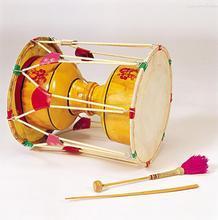zhanggu overview
 The stick drum (pinyin: zhàng gǔ), the Korean mixed percussion instrument, also known as the long drum, is called bu in Korean. Popular in Liaoning, Jilin, Heilongjiang, Inner Mongolia, Hebei and other provinces, especially in Yanbian Korean Autonomous Prefecture in Jilin Province. The timbre of the stick drum is soft, and it is often used for singing and dancing accompaniment and instrumental ensemble. It is a national musical instrument that is deeply loved by the Korean people.
The stick drum (pinyin: zhàng gǔ), the Korean mixed percussion instrument, also known as the long drum, is called bu in Korean. Popular in Liaoning, Jilin, Heilongjiang, Inner Mongolia, Hebei and other provinces, especially in Yanbian Korean Autonomous Prefecture in Jilin Province. The timbre of the stick drum is soft, and it is often used for singing and dancing accompaniment and instrumental ensemble. It is a national musical instrument that is deeply loved by the Korean people.Fujian stick drum, also known as Fuzhou drum, wolf tent, wolf stick, wolf string, wolf stick drum, wolf singing. Evolved from the two-stick drum in ancient China, it is a traditional percussion instrument in Fujian folk. The Fuzhou language is called "wolf tent" (long cuong), which is the pronunciation of the Chinese character "two sticks". The stick drum disappeared in the Central Plains in the Qing Dynasty. Today, the slender hourglass-shaped drum is extremely rare among the Han musical instruments. The wolf tent drum preserved in Fujian is a living fossil of Chinese musical instruments. It is mostly used for Fujian Opera accompaniment and Fujian folk instrumental ensemble "Fuzhou Chating Shifan Music", Quanzhou Longchui, "Zhangzhou Nanci", "Taiwan Shiquan Tune" and other Fujian folk music. At the same time, it is also an indispensable musical instrument in folk activities such as Yingshen competitions, gongs and drums competitions in the Shiyi area of Fuzhou, as well as Yanping, Ningde, Minzhongnan, Taiwan Matsu and other places. It is a truly unique musical instrument with Fujian and Vietnam characteristics
Korean stick drum stick drum, also known as the Korean long drum. Korean mixed percussion instrument. In Korean, it is called bu. With a long history, unique structure and soft tone, it is often used for singing and dancing accompaniment and instrumental ensemble. Popular in Liaoning, Jilin, Heilongjiang, Inner Mongolia, Hebei and other provinces, especially in Yanbian Korean Autonomous Prefecture in Jilin Province.
The industrious and simple Korean people mainly live in the Yanbian Korean Autonomous Prefecture in the east of Jilin Province, where the mountains and rivers are beautiful, the scenery is gorgeous, and the songs are everywhere. Yanji, the capital of the autonomous prefecture, is known as the "Hometown of Song and Dance" and "City of Culture". During holidays, weddings, birthdays, or after labor, in the streets, parks or courtyards, women in colorful dresses, 60-year-old old people or children will be seen dancing limply, and they will hear the accompaniment of the clanging sticks and drums. Next, music with national characteristics and exciting singing.
As stated in "Records of the Three Kingdoms, Wei Shu, Dongyi Biography": "Koguryo... Its people like to sing and dance. It can be seen that the Korean people have a long history of being good at singing and dancing. The stick drum originated in India, and was introduced into the Central Plains of my country in the 4th century AD, and later spread to Korea. In the murals of the Northern Wei Dynasty in Dunhuang and the relief sculptures of the Northern Wei Dynasty in the Yungang Grottoes, the early dance music images of stick drums can be seen. During the Sui and Tang Dynasties, the Central Plains also called the stick drum as Dutan drum, Mao Yuan drum and waist drum. "Old Tang Book Music Records" (Volume 29) contains: "The waist drum, the big one is tile, the small one is wood, all have wide heads and slender abdomens, and the original Hu drums are also drums. . . . , and hit it with a mallet. The Mao Yuan drum seems to be a drum and a little bigger." It also indirectly explains the name and shape of the early stick drum. Although it did not have the name of stick drums in the Sui and Tang Dynasties, it was actually used in the music of Tianzhu, Qiuci, Xiliang, Shule, Gaochang and Gaoli in the nine and ten pieces of music.
- Pinyin:zhàng gǔ
- popular area:Fujian, Liaoning, Jilin, Heilongjiang
- structure:Drum body, slender, hollow
- Classification:percussion
overview of other similar instruments
- sanyanxiao overview
- Daguangxian overview
- Leiqin overview
- hahao overview
- yandundagu overview
- Han Xiaozheng overview
- Fang Xiang overview
- guanzi overview
- zhuqin (Dao Qin) overview
- zhuiqin overview
- bangzi overview
- three-stringed piano overview
- Gehu overview
- xiao overview
- xiaokonghou overview
- Konghou overview
- Sheng overview
- suona overview
- hulusi overview
- gushao overview
 渝公网安备 50010702504639号
渝公网安备 50010702504639号